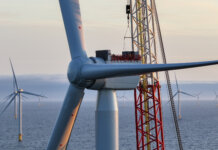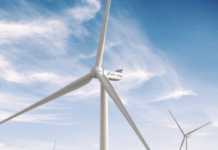Wind turbines are designed to have a lifetime of 20 to 25 years. It has been shown, however, that many can continue to operate for several years beyond their planned service lives. A lifetime extension assessment can determine whether a wind turbine is suitable for continued operation past its design life.
When wind turbines reach the end of their original lifespan, operators are thus faced with the important decision of whether to decommission, repower or keep their wind turbines in service. To establish whether the lifetime of a turbine may be prolonged, its physical condition needs to be evaluated and the theoretical potential at the specific site must be determined with the aim to know what the real lifetime of the turbine is and how long a safe operation is possible.
The examination to assess the potential of a turbine consists of two parts: an analytical evaluation and an on-site inspection, which are conducted in parallel. One of the principal aims is to assess the structural stability of the turbine. All load-bearing elements and components contributing to the structural stability are scrutinized. These parts include the tower and foundation; screws and bolts; hub; shaft; rotor blades; braking systems; and safety functions.
During the analytical part of the assessment, wind and performance data, technical documents, maintenance and repair reports are evaluated. Environmental operating data and technical documents are used to calculate the potential duration of continued operation for all relevant parts of the turbine. Wind turbine operators are responsible for submitting these data and for scheduling the inspection on time.
In particular, average wind speeds, turbulence intensities and extreme wind events for the previous 20 years should be available. Historical wind conditions are used to calculate loads for the period of operation. Operating data and data from the anemometer on the nacelle are the basis for this calculation. If figures are missing, long-term extrapolation can be performed using other data sets, e.g., reanalysis data. In the case of a turbine located in a wind farm with various capacity additions, turbulence intensity is calculated for each individual turbine.
The technical documents required include the type certificate, operating permit, documentation relating to the construction and commissioning of the turbine, operating and yield data, wiring and hydraulic diagrams, and maintenance, repair and inspection reports. In addition, a technical report about the conditions of the rotor blades over the last year of operation needs to be submitted.
If the technical documentation is incomplete, the missing certificates and documents can usually be obtained from the manufacturer. Even if the manufacturer is no longer available, assessments based on previous experience or comparisons with other turbines can be made to bridge the knowledge gaps.
Historical operating conditions are compared with the conditions assumed during the design of the wind turbine. In particular, the actual loads faced by a turbine are compared with the loads for which the turbine was planned. Both these data sets are derived from computer simulations that reflect design conditions after type-testing, as well as environmental operating conditions. An on-site inspection of the turbine is also carried out.
Following this analysis, an initial statement is produced highlighting any immediate requirements and specifying the conditions necessary to prolong the lifetime of the turbine. The measures listed often include repairs to the rotor blades or precautionary replacement of bolts. As a result, an accurate financial estimate of the resulting costs of a lifetime extension can be made.
The purpose of the practical assessment is to document any damage or faults in the equipment and changes in the surrounding environment of the turbine. The conditions of the main elements of the turbine are examined in detail. The rotor blade, the gearbox, the supporting structure and the foundation are inspected. All load-bearing and safety-relevant parts are checked for cracks, signs of corrosion and unusual noises in the gearbox or other gear and bearing assemblies. The turbine is assessed for specific weaknesses emerging from the analytical evaluation or flaws associated with a particular type of turbine. Changes in the surrounding environment of a wind farm since its commissioning are also documented and taken into account in wind turbulence calculations.
The results of previous lifetime assessments show that frequently, the supporting structure of the turbine is free from significant damage, as wind conditions at the site often result in lower loads than originally estimated.
Thus, the lifetime of wind turbines can, in many cases, be prolonged following completion of minor and low-cost repairs that require only a limited period of downtime. However, in the unlikely event that significant damage compromising the safety of continued operation is detected, the immediate shutdown of the turbine would be recommended. In that case, the financial costs of replacing or repairing the faulty components need to be taken into consideration.
A safety assessment is usually performed during the last year of validity of the operating permit of the turbine. However, in the case of divestment or medium-term budget planning, it may be preferable to conduct it at an earlier stage. In these instances, a physical inspection is not required. The findings of the analysis are based on calculations and provide an estimate; they can be incorporated into a lifetime extension assessment at a later point in time. These preliminary results indicate whether continued operation is possible and when specific components are likely to need replacing.
At the end of a lifetime extension assessment, operators receive an in-depth report specifying the time remaining until design loads are reached and highlighting the risks and opportunities resulting from continued operation of the turbine. This is an important tool for wind turbine operators, as it assists them in their decision-making process. The results of the assessment can also be used to optimize maintenance costs throughout the remaining lifetime of the turbine.
Christian Schumacher focuses on wind turbine certification, and Florian Weber works in the wind service center of TÜV SÜD Industrie Service GmbH.




